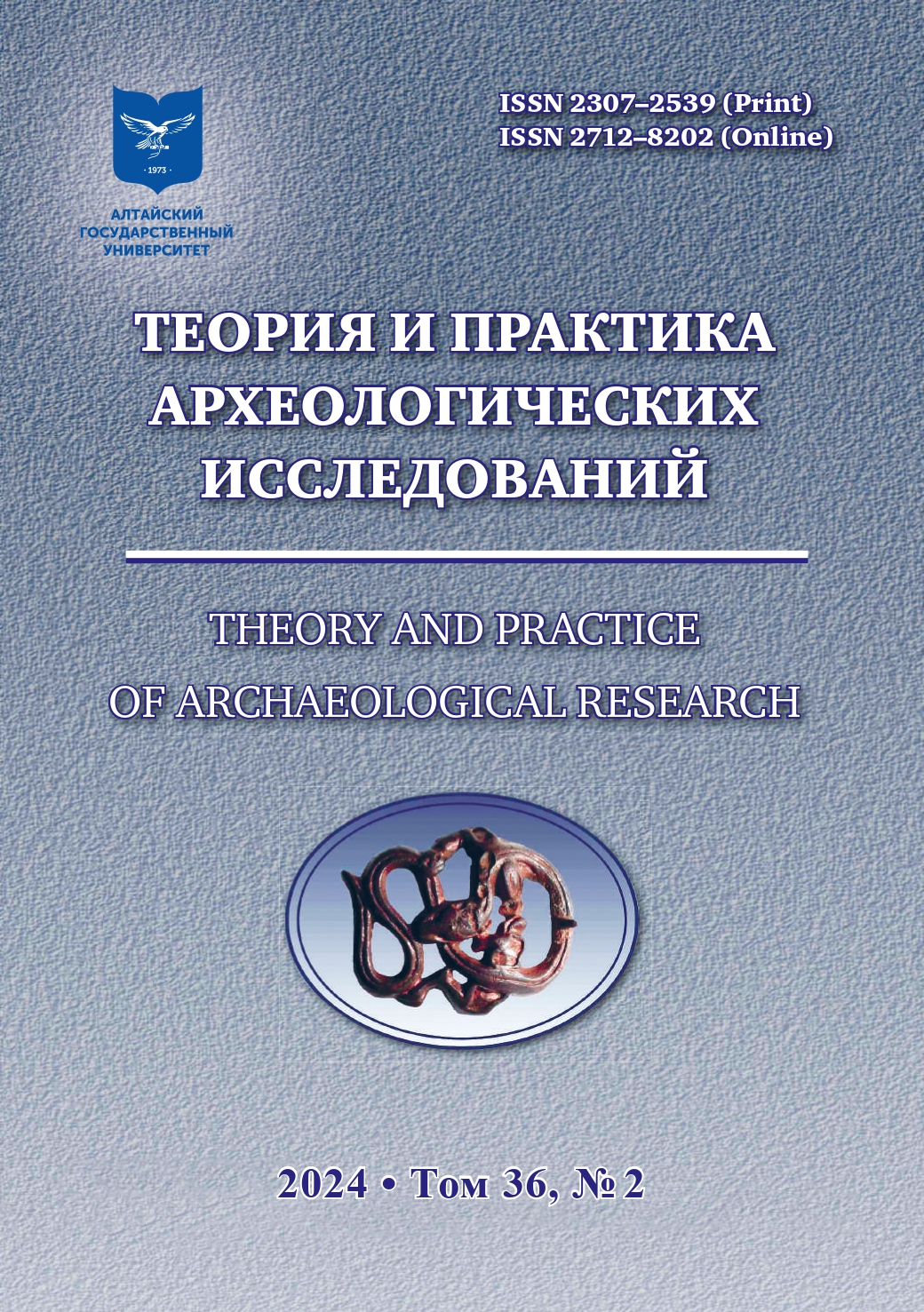NORTH CAUCASIAN, DON AND PODNEPROVSKY IMPORTS IN BRIDLE SETS FROM THE BARROWS OF THE “HIGH GRAVE — STUDENIKIN MAR“ NECROPOLIS IN THE SOUTHERN URALS
Abstract
The article examines a series of items from the bridle sets of the “Vysokaya Mogila — Studenikin Mar” necropolis in the Southern Urals. The burial mound necropolis belongs to the nomadic nobility of the Southern Ural nomads of the 4th century BC. In terms of their design features, burial rites, and inventory, the necropolis mounds have direct analogies with the complexes of the famous Filippovka-1 burial ground and are part of the Filippovka circle of sites. The bridle sets found in the sacrificial complexes and burials of large mounds have wide parallels in the Scythian and Meotian complexes of the North Caucasus, the Don region, and the Dnieper region. Chronologically, the bridle accessories found date back to the mid-4th — early 3rd centuries BC. All items were found in rich complexes and are of great importance for the chronology of the culture of the early nomads of the Southern Urals. In addition, the discovered inventory categories characterize the geographical scope, level and chronological dynamics of the connections and contacts of the South Ural nomads with adjacent territories.Downloads
Metrics
No metrics found.
References
Alekseev A.Yu. Chronography of European Scythia in the 7th–6th Centuries BC. St. Petersburg : Izd-vo Gos. Ermitazha, 2003. 410 p. (In Russ.)
Valchak S.B. About one of the functional details of the Scythian bridle of Eastern Europe.
In: Archaeology of the Middle Don in the Scythian Era: Works of the Don Archaeological Expedition of the Institute of Archaeology of the Russian Academy of Sciences, 2004–2008. Moscow : IA RAN, 2009. Pp. 126–140. (In Russ.)
Vasiliev V.N. On the Chronology of the Early Prokhorovsky Complex. Ufimskij arheologicheskij vestnik = Ufa Archaeological Bulletin. 2004;5:153–172. (In Russ.)
Influences of Achaemenid Culture in the Southern Urals (the 5th–3rd Centuries BC). Volume I, II / Eds. M.T. Traister, L.T. Yablonsky. Moscow : Taus, 2012. Vol. I. 671 p. Vol. II. 468 p.
Gulyaev V.I., Savchenko E.I. A New Site of the Scythian Time on the Middle Don. In: Archaeology of the Middle Don in the Scythian era: Works of the Don (Potudan) Archaeological Expedition of the Institute of Archives of the Russian Academy of Sciences, 2001–2003. Moscow : IA RAN, 2004. Pp. 35–52. (In Russ.)
Dedyulkin A.V., Kayumov I.F., Meshcheryakov D.V. Hellenistic Iron Cuirasses from the South Ural Region. Stratum plus. 2019;3:51–88. (In Russ.)
Zhdanovsky A.N. Mound No. 30 near the Village of Necherziy. In: Raev B.A., Bespalyi G.E. A Mound of Scythian Times on the Ground Burial Ground of the IV Novolabinsk Settlement. Rostov-on-Don : Izd-vo YuNC RAN, 2006. Pp. 87–100. (In Russ.) Ilyinskaya V.A. Scythians of the Dnieper Forest-Steppe Left Bank. Kyiv : Naukova Dumka, 1968. 267 p. (In Russ.)
Kantorovich A.R. Scythian Animal Style of Eastern Europe: Classification,Typology, Chronology, Evolution: Dis. ... Dr. Hist. Sciences. Moscow, 2015. 1724 p. (In Russ.)
Kantorovich A.R., Yablonsky L.T. On the Northern Black Sea and North Caucasian Parallels to Images in the Scythian-Siberian Animal Style on the Objects from the Filippovsky Burial Mounds. Nizhnevolzhskij arheologicheskij vestnik = Nizhnevolzhsky Archaeological Bulletin. 2009;10:73–99. (In Russ.)
Leskov A.M., Beglova E.A., Ksenofontova I.V., Erlich V.R. Meotians of Trans-Kuban Region of the 4th–3rd Centuries BC. Necropolises near the Aul of Ulyap. Shrines and Ritual Places. Moscow : GMV, 2013. 184 p. (In Russ.)
Limberis N.Yu., Marchenko I.I. Iron Bits with Strict Attachments from the Meotian burial Grounds of the Kuban Region. In: Crimea in the Sarmatian Era (2nd century BC — 5th century AD). Simferopol : Salta LTD, 2019. Pp. 161–174. (In Russ.)
Limberis N.Yu., Marchenko I.I. On some Categories of Meotian Imports in Early Sarmatian Burials. In: Regional Features of the Chronology and Periodization of the Sauromatian and Sarmatian Cultures. Volgograd : Izd-vo VolGU, 2023. Pp. 114–127. (In Russ.)
Maksimenko V.E., Klyuchnikov V.V., Gurkin S.V. The Study of the Burial Ground “Chastyye kurgany II” on the Lower Don in 2008 (preliminary publication). In: Archaeology of the Middle Don in the Scythian Era: Works of the Podunan Archaeological Expedition of the Institute of Archives of the Russian Academy of Sciences. Moscow : IA RAN, 2000. Pp. 220–225. (In Russ.)
Maksimenko V.E., Smirnov K.F., Gorbenko A.A., Lukyashko S.I. Rich Early Sarmatian Complexes of the Right Bank of the Don. In: Smirnov K.F. Sarmatians and the Establishment of Their Political Dominance in Scythia. Moscow : Nauka, 1984. Pp. 124–141. (In Russ.)
Marchenko I.I., Limberis N.Yu. Lamellar Horse Foreheads from the Kuban Region. Arheologiya, etnografiya i antropologiya Evrazii = Archaeology, Ethnography and Anthropology of Eurasia. 2009;3 (39):69–74. (In Russ.)
Maslov V.E. The Swords of Sindian-Maeotian Type vs. Akinakes: current realities. Stratum plus. 2019;3:133–154. (In Russ.)
Meshcheryakov D.V., Yablonsky L.T. About Some Caucasian Imports in the Sites of the Early Sarmatian Time of the Southern Urals. In: North Caucasus and the World of Nomads in the Early Iron Age : Collection in Memory of M.P. Abramova. Moscow : Taus, 2007. Pp. 357–368. (In Russ.)
Mogylov O.D. Equipment of a Horse of the Scythian Era in the Forest Steppe of Eastern Europe. Kyiv; Kamianets-Podilskyj : IA NANU, 2008. 439 p. (In Ukr.)
Mogilov A.D. “Rigid” Details of the Early Iron Age Bridle. Stratum plus. 2010;3:281–288. (In Russ.)
Ochir-Goryaeva M.A. Ancient Horsemen of the Eurasian Steppes. Moscow : Taus, 2012. 472 p. (In Russ.)
Prokopenko Yu.A. Scythians, Sarmatians and Tribes of the Koban Culture of the Central Ciscaucasia in the Second Half of the 1st Millennium BC. Vol. 1, 2. Stavropol : Izd-vo SKFU, 2014. Vol. 1. 446 p. Vol. 2. 726 p. (In Russ.)
Prokopenko Yu.A. Head and Cheek Plates of Horse Headdresses of the 4th–2nd Centuries. BC. from the Sites of the Stavropol Upland. Materialy po arheologii i istorii antichnogo i srednevekovogo Prichernomor’ya = Materials on the Archaeology and History of the Ancient and Medieval Black Sea Region. 2021;13:467–482. (In Russ.)
Prokopenko Yu.A. Lamellar Horse Foreheads from the Late 4th — early 2nd Centuries BC from the Sites of the Central Ciscaucasia. In: Regional Features of the Chronology and Periodization of the Sauromatian and Sarmatian Cultures. Volgograd : Izd-vo VolGU, 2023. Pp. 128–133. (In Russ.)
Puzikova A.I. Funerary Inventory from Burial Mounds of the Scythian Period in the Middle Don Region. Moscow : IA RAN, 2017. 160 p. (In Russ.)
Pshenichnyuk A.Kh. Filippovka. Necropolis of the Nomadic Nobility of the 4th Century BC in the Southern Urals. Ufa : IIYaL UNC RAN, 2012. 280 p. (In Russ.)
Savelyev N.S. Scythian Bridle in the Forest-Steppe of the Southern Urals: the End Point of the Western Impulse. Stratum plus. 2020;3:31–52. (In Russ.)
Savchenko E.I. Horse Equipment of the Scythian Era on the Middle Don as an
Archaeological Source. In: Archaeology of the Middle Don in the Scythian Era: Works of the Don Archaeological Expedition of the Institute of Archaeology of the Russian Academy of Sciences, 2004–2008. Moscow : IA RAN, 2009. Pp. 221–325. (In Russ.)
Sirotin S.V. Items of Horse Harnesses from the Mounds of the Early Nomads of the Southern Urals (based on materials from excavations of 2008–2013). In: Ethnic Interactions in the Southern Urals. Chelyabinsk : Chelyabinskij gosudarstvennyj kraevedcheskij muzej, 2015. Pp. 247–256. (In Russ.)
Sirotin S.V. About One Group of Plate Foreheads in the Bridle Sets of the Early Nomads of the Southern Urals. In: Crimea in the Sarmatian era (2nd century BC — 5th century AD). Simferopol : Salta LTD, 2019. Pp. 224–233. (In Russ.)
Sirotin S.V Arched Objects (noseband) as a Part of a Horse Harness of the Early Nomadsof the Southern Urals. Nizhnevolzhskij arheologicheskij vestnik = Nizhnevolzhsky Archaeological Bulletin. 2020;19(1):102–115. (In Russ.)
Sirotin S.V. Dromos Burial of the 4th Century BC from Mound No12 of the Perevolochan-I Necropolis in the Southern Urals. Kratkie soobshcheniya Instituta arheologii = Brief Notes of the Institute of Archaeology. 2020а; 258:181–200. (In Russ.)
Sirotin S.V., Bogachuk D.S. About the Connections of the Early Nomads of the Southern Urals with the North Caucasus, the Lower and Middle Don Region in the 4th Century BC. In: Eurasian Steppe Civilization: the Man and Historical and Cultural Environment. In 5 Vol. Almaty — Turkestan : Institut arheologii im. A.H. Margulana, 2022. Vol. 2. Pp. 99–105. (In Russ.)
Sirotin S.V., Bogachuk D.S., Okorokov K.S. Filippovsky Parallels in the Funeral Rite of Large Mounds of the “Vysokaya Mogila — Studenikin Mar” Necropolis. In: Early Nomads of the Southern Urals and Lower Volga Region. Moscow : MAKS PRESS, 2020. Pp. 203–217. (In Russ.)
Sirotin S.V., Bogachuk D.S., Okorokov K.S. Western and Eastern Imports in the Complexes of Mound 1 of the Studenikin Mar Group of the “Vysokaya Mogila — Studenikin Mar” Necropolis in the Southern Urals. Arheologiya evrazijskih stepej = Archaeology of the Eurasian Steppes. 2022;5:271–281. (In Russ.)
Sirotin S.V., Bogachuk D.S., Okorokov K.S. Military Complex with the Elements of Defensive Weapons of the Early Prokhorovsky Time from the Southern Urals. In: Digest of Materials of the VII All-Russian Lower Volga Archaeological Conference. Astrakhan : Izdatel: Sorokin Roman Vasil’evich, 2023. Pp. 82–87. (In Russ.)
Skripkin A.S. Sarmatians. Volgograd : Izd-vo VolGU, 2017. 293 p. (In Russ.)
Smirnov K.F. About the Swords of the Sindo-Meotian Type. Kratkie soobshcheniya Instituta arheologii = Brief Notes of the Institute of Archaeology. 1980;162:38–45. (In Russ.)
Smirnov K.F. Sarmatians and the Establishment of Their Political Dominance in Scythia. Moscow : Nauka, 1984. 183 p. (In Russ.)
Tairov A.D. Early Iron Age. In: Ancient History of the Southern Trans-Urals. Vol. 2. CHelyabinsk : Izd-vo YuUrGU, 2000. Pp. 3–305. (In Russ.)
Erlikh V.R. Connections of the Kuban Region with the Volga Region and the Urals in the Second Half of the 4th Century BC (based on materials from the Tengin sanctuaries). In: City and Steppe in the Euro-Asian Contact Zone. Moscow : Numizmaticheskaya literaturа, 2006. Pp. 60–62. (In Russ.)
Erlikh V.R. The Bridle of Colchis and Central Georgia of the Ancient Era: to the Problem of Identifying Traditions. In: Archaeology and Paleoanthropology of Eurasian Steppes and Adjacent Territories. Moscow : Taus, 2010. Pp. 73–106. (In Russ.)
Yablonsky L.T. Prokhorovka. At the Beginnings of Sarmatian Archaeology. Moscow : Taus, 2010. 384 p. (In Russ.)
Yablonsky L.T. Gold of the Sarmatian Leaders. Elite Necropolis Filippovka-1 (based on materials from excavations in 2004–2009). Collection Catalogue. Book 1. Moscow : IA RAN, 2013. 232 p. (In Russ.)
Yablonsky L.T., Bogachuk D.S., Volodin S.A., Maslov V.E., Sirotin S.V. Gold of the Sarmatian Leaders. Necropolises Filippovka-1 and Filippovka-2. Collection Catalogue. Book II. Moscow : IA RAN, 2023. 356 p. (In Russ.)
Copyright (c) 2024 C.В. Сиротин

This work is licensed under a Creative Commons Attribution 4.0 International License.
Theory and Practice of Archaeological Research is a golden publisher, as we allow self-archiving, but most importantly we are fully transparent about your rights.
Authors may present and discuss their findings ahead of publication: at biological or scientific conferences, on preprint servers, in public databases, and in blogs, wikis, tweets, and other informal communication channels.
Theory and Practice of Archaeological Research allows authors to deposit manuscripts (currently under review or those for intended submission to ABS) in non-commercial, pre-print servers such as ArXiv.
Authors who publish with this journal agree to the following terms:
- Authors retain copyright and grant the journal right of first publication with the work simultaneously licensed under a Creative Commons Attribution License (CC BY 4.0) that allows others to share the work with an acknowledgement of the work's authorship and initial publication in this journal.
- Authors are able to enter into separate, additional contractual arrangements for the non-exclusive distribution of the journal's published version of the work (e.g., post it to an institutional repository or publish it in a book), with an acknowledgement of its initial publication in this journal.
- Authors are permitted and encouraged to post their work online (e.g., in institutional repositories or on their website) prior to and during the submission process, as it can lead to productive exchanges, as well as earlier and greater citation of published work (See The Effect of Open Access).








2.jpg)




